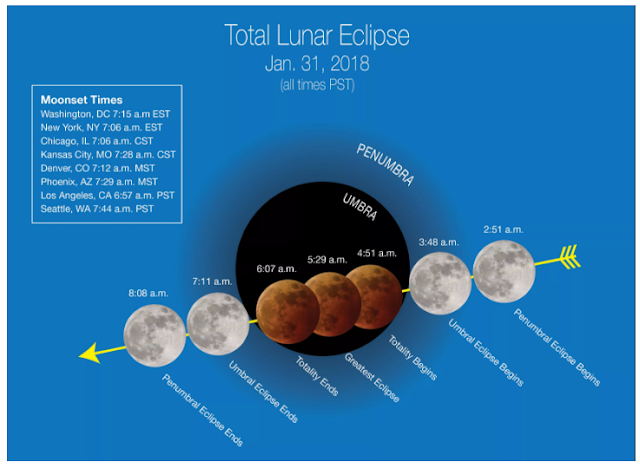SUPERMOON On Jan 31
Blue moon
2018: How to see the supermoon on Jan 31.
Jan.
31 will be a trifecta of lunar awesomeness. For the first time in 150 years, there will be a super blue blood
moon. This means:
Ø The moon will be a
"supermoon," which is when the Earth is closer than usual to its
satellite. The moon will be 223,068 miles (358,994 km) from Earth, instead of
the average distance of 238,855 miles (384,400 km), making the moon 14 percent
brighter than usual, according to NASA.
Ø It's the second full moon
of the month, which is known as a "blue moon." This doesn't make it
look any different, it's just a quirk of the calendar.
Ø The moon will also be
moving through the Earth's shadow, which will create a total lunar eclipse in
some areas. This will give it a reddish tint, which is called a "blood
moon."
Where
it will appear
Unfortunately, not everyone will get a live, front-row
seat to the super blue blood moon.
"For the (continental) US, the viewing will be
best in the west," said Gordon Johnston, program executive and lunar
blogger at NASA Headquarters in Washington.
Here's how things break down:
Ø The best viewing time for the east coast is 6:45 a.m. ET. You'll
need to be in a high location to see the moon, because it will be so low in the
west-northwest sky.
Ø Those in the middle of the US with a Central time zone will be
able to see the start of the eclipse at 4:51 a.m. CT. From 6:15 to 6:30 a.m. CT
will be the best viewing time.
Ø People living in the Rocky Mountain region will get the best view
around 6:30 a.m. MT.
Ø The west coast will get the best view from between about 5 and 6
a.m. PT.
Ø Asia, the Middle East, Australia, eastern Russia and New Zealand
can see the eclipse during the morning moon rise on Jan. 31, according to NASA.
Sorry, UK
Check this video and get amazed: https://youtu.be/IrydklNpcFI




Comments
Post a Comment